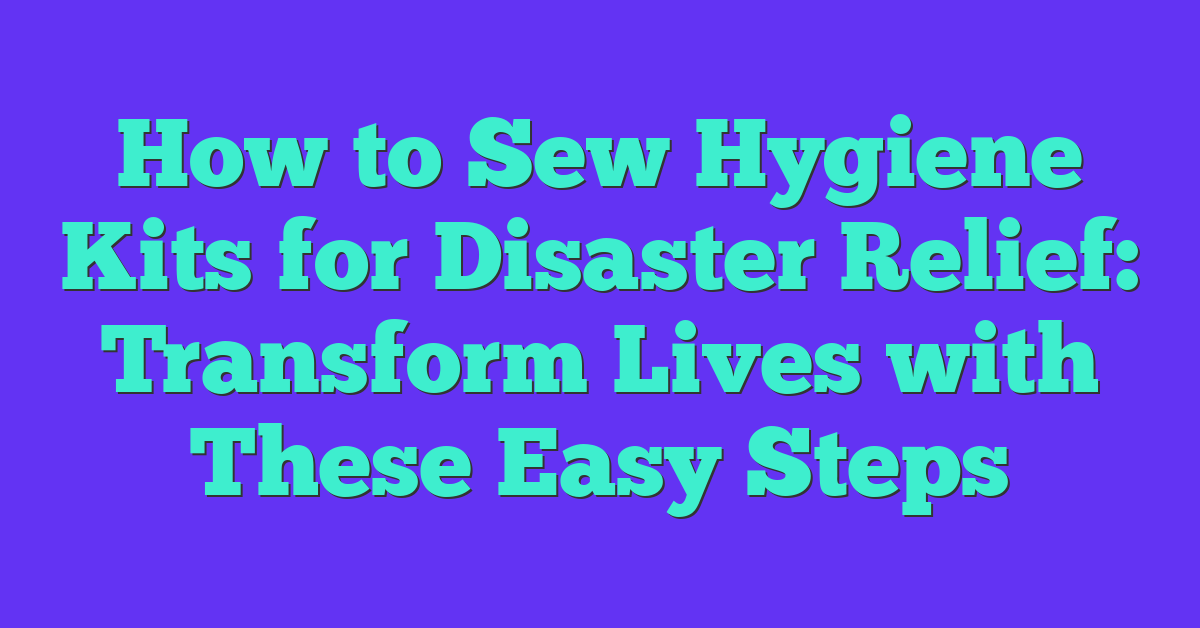Disaster strikes when we least expect it, leaving communities vulnerable and in need of support. You have the power to make a real difference by sewing hygiene kits that provide essential care to those affected.
With just a few basic materials and some sewing know-how, you can create packages that bring comfort and dignity in challenging times. Whether you’re seasoned with a needle or just starting out, this guide will walk you through the steps to assemble effective hygiene kits for disaster relief.
Imagine being able to offer a lifeline to families recovering from a disaster. Sewing hygiene kits not only supplies necessary items like soap and toothbrushes but also shows compassion and solidarity. You’ll learn how to choose the right materials, organize the contents, and efficiently assemble the kits to ensure they reach those who need them most.
Choosing the Right Materials
Selecting appropriate materials ensures your hygiene kits are durable and effective in disaster relief situations.
Fabrics and Threads
- Durable Fabrics: Use cotton or polyester for strength and ease of washing.
- Water-Resistant Materials: Incorporate nylon or Gore-Tex to protect contents from moisture.
- Reinforced Threads: Opt for polyester or nylon threads to ensure seams hold under stress.
- Color Selection: Choose neutral colors like blue or green for a professional appearance.
- Soft Linings: Add fleece or felt to provide cushioning for delicate items.
Essential Hygiene Items
- Soap Bars: Include biodegradable options for safe disposal.
- Toothbrushes and Toothpaste: Pack travel-sized kits for convenience.
- Sanitary Pads: Provide a sufficient quantity to meet immediate needs.
- Hand Sanitizer: Opt for alcohol-based solutions with at least 60% concentration.
- Wet Wipes: Select fragrance-free varieties to accommodate sensitive skin.
| Item | Quantity per Kit |
|---|---|
| Soap Bars | 2 |
| Toothbrushes | 1 |
| Toothpaste Tubes | 1 |
| Sanitary Pads | 10 |
| Hand Sanitizer | 1 bottle |
| Wet Wipes | 20-pack |
Preparing Your Sewing Space
A well-organized sewing space enhances your efficiency and ensures a smooth workflow. Set up your area to keep all necessary tools within reach.
Organizing Supplies
- Workspace Layout
- Allocate a clear, flat surface for cutting and assembling kits.
- Ensure adequate lighting to prevent strain and enhance precision.
- Essential Tools
- Sewing Machine: Keep it charged and in good working condition.
- Needles and Threads: Store various sizes and colors in labeled containers.
- Scissors and Cutting Tools: Use separate scissors for fabric and paper.
- Measuring Tools: Have rulers, tape measures, and marking tools readily available.
- Material Storage
- Organize fabrics, water-resistant materials, and linings in separate bins.
- Keep hygiene items like soap bars, toothbrushes, and sanitizers within easy reach.
- Use shelves or drawers to sort items by type and size for quick access.
- Assembly Station
- Designate a specific area for stitching components together.
- Keep a checklist nearby to track progress and ensure all items are included.
Safety Precautions
- Tool Safety
- Handle scissors, needles, and other sharp tools with care.
- Store tools in a secure place when not in use to prevent accidents.
- Electrical Safety
- Inspect your sewing machine for any damages before use.
- Keep cords away from walkways to avoid tripping hazards.
- Ergonomics
- Set your workspace at a comfortable height to reduce strain.
- Take regular breaks to prevent fatigue and maintain focus.
- Fire Safety
- Keep a fire extinguisher nearby in case of emergencies.
- Avoid overloading electrical outlets to reduce fire risks.
- First Aid
- Have a basic first aid kit accessible for minor injuries.
- Know the location of emergency contacts and facilities.
By organizing your supplies and adhering to safety precautions, you create a productive and secure environment for assembling hygiene kits efficiently.
Step-by-Step Sewing Instructions
Follow these instructions to create durable and organized hygiene kits efficiently.
Cutting and Measuring Fabric
Start by accurately measuring fabric to ensure each component fits correctly. Use a measuring tape to obtain precise dimensions for each compartment. Mark the measurements with fabric chalk before cutting to avoid errors. Utilize sharp fabric scissors or a rotary cutter for clean edges. Refer to the table below for standard measurements:
| Component | Width (inches) | Height (inches) |
|---|---|---|
| Outer Pouch | 12 | 10 |
| Inner Pocket | 10 | 8 |
| Divider Sections | 2 | 10 |
Arrange the fabric pieces on a flat surface, aligning patterns consistently to minimize fabric waste. Double-check all measurements before cutting to maintain uniformity across all kits.
Assembling the Kit Compartments
Begin assembling by stitching the divider sections into the outer pouch. Place the dividers evenly to create separate compartments. Use reinforced stitching at each seam to enhance durability. Ensure each compartment aligns correctly with the measured dimensions.
Next, attach the inner pockets to the designated compartments. Position pockets securely to hold hygiene items without shifting. Use a zigzag stitch for added strength around the pocket edges. Verify that all pockets are accessible and provide sufficient space for the intended items.
Finally, secure the outer edges of the pouch by topstitching around the perimeter. This step reinforces the structure and prevents the fabric from fraying. Inspect each kit for consistency and quality, making adjustments as necessary to ensure each hygiene kit meets the required standards.
Packing the Hygiene Kits
Efficient packing ensures each hygiene kit meets the needs of disaster-affected individuals. Organize items systematically to maximize utility and accessibility.
Selecting and Arranging Items
Choose essential hygiene products that address immediate needs:

- Biodegradable Soap Bars: Include two per kit for daily cleansing.
- Travel-Sized Toothbrushes and Toothpaste: Provide one toothbrush and one toothpaste tube.
- Sanitary Pads: Pack five pads to ensure adequate supply.
- Alcohol-Based Hand Sanitizer: Add a 100ml bottle for hand hygiene.
- Fragrance-Free Wet Wipes: Include a pack of 20 wipes for versatile cleaning.
Arrange items in designated compartments within the kit:
- Top Section: Place wet wipes and hand sanitizer for easy access.
- Middle Section: Organize soap bars and toothpaste together.
- Bottom Section: Store sanitary pads securely to maintain privacy.
Securing and Labeling Kits
Ensure each kit remains intact and easily identifiable:
- Secure Closures: Use strong Velcro strips or zipper closures to keep items from spilling.
- Reinforced Seams: Stitch all edges with double stitching for durability.
- Labeling: Attach clear labels indicating contents and usage instructions.
- Content Labels: Use waterproof labels for each compartment.
- Usage Instructions: Provide concise guidance on item usage for recipients.
Implement a quality check:
- Inspection: Verify each kit is complete and properly sealed.
- Consistency: Ensure uniform packing standards across all kits.
| Kit Component | Quantity per Kit |
|---|---|
| Biodegradable Soap Bars | 2 |
| Toothbrushes | 1 |
| Toothpaste Tubes | 1 |
| Sanitary Pads | 5 |
| Hand Sanitizer (100ml) | 1 |
| Wet Wipes | 20 |
By meticulously selecting, arranging, securing, and labeling each hygiene kit, you guarantee that recipients receive reliable and organized support during emergencies.
Distributing the Kits
Once your hygiene kits are assembled, distributing them effectively ensures they reach those in need promptly.
Identifying Target Areas
You Won’t Believe How Art Deco Transformed 1920s Sewing – Find Out Now »
Determine regions affected by disasters using data from reliable sources like government agencies or international organizations. Assess the severity of the impact by reviewing reports on infrastructure damage, population displacement, and immediate needs. Prioritize areas with limited access to clean water, medical facilities, and sanitation services to maximize the kits’ effectiveness.
Coordinating with Relief Organizations
Partner with established relief organizations to streamline distribution efforts. Reach out to groups such as the Red Cross, UNICEF, or local NGOs that have existing networks and logistics in place. Share details about your hygiene kits, including contents and quantity, to align your resources with their distribution plans. Collaborate on scheduling delivery times, transportation methods, and safe distribution locations to ensure the kits reach recipients efficiently and securely.
Conclusion
Creating hygiene kits is a meaningful way to make a real difference when disaster strikes. Your efforts can bring comfort and hope to those who need it most.
By taking the time to sew and assemble these kits, you’re providing essential care that helps restore dignity during tough times. Every kit you put together has the power to uplift and support a family in their time of need.
Stay motivated and remember that your contribution matters. Together we can build stronger communities and ensure that help reaches those who need it quickly and effectively.


















